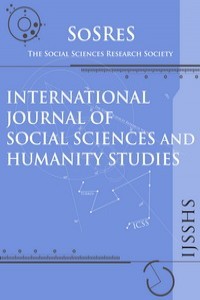THE EFFECT OF TRANSFORMATIONAL LEADERSHIP ON ORGANIZATIONAL IDENTIFICATION AND PERCEIVED CORPORATE REPUTATION: A UNIVERSITY SAMPLE
THE EFFECT OF TRANSFORMATIONAL LEADERSHIP ON ORGANIZATIONAL IDENTIFICATION AND PERCEIVED CORPORATE REPUTATION: A UNIVERSITY SAMPLE
Transformational Leadership, Organizational Identification, Perceived Corporate Reputation,
___
- Ashforth, B. E. ve F. Mael (1989), “Social Identity Theory and The Organizations”, Academy of Management Review, 14, pp:20-39.
- Argenti, Paul A., Bob Druckenmiller, (2004), “Reputation and the Corporation
- Brand”, Corporate Reputation Review, 6 (4), pp:368–274. Arslantaş, C. Cüneyt, (2007), “Dönüşümcü Liderliğin Psikolojik Güçlendirme ve Örgütsel Vatandaşlık Davranışı Üzerindeki Etkisi”, Amme İdaresi Dergisi, Cilt:40 Sayı:4 ss. 81-101.
- Avolio, B. J., B. M., Bass, D. I., Jung, (1999), “Reexamining the components of transformational and transactional leadership nursing the multifactor leadership
- Questionnaire” Journal of Occupational and Organizational Psychology, 72, pp: −462. Bhattacharya, C.B, H., Roa, M.A. Glynn, (1995), “Understanding The Bond Of
- Identification: An Investigation Of Its Correlates Amang Art Museum Members”, Journal Of Marketing, pp: 46-57
- Bass, B.M., (1985), Leadership And Performance Beyond Expectations. New York: FreePress.
- Baron, R. M., ve Kenny, D. A. (1986). “The moderator-mediator variable distinction in social psychological research: Conceptual, strategic, and statistical considerations” Journal of Personality and Social Psychology, 51, 1173-1182
- Bass, B.M., (1985), Leadership And Performance Beyond Expectations. New York: FreePress.
- Burns, J.M., (1978), Ledership. New York: Harper&Row.
- Epitropaki, Olga, Robin Martin; (2005), “The moderating role of individual differences in the relation between transformational/transactional leadership perceptions and organizational identification”, The Leadership Quarterly 16 pp: –589
- Gotsi, M. and A.M. Wilson, (2001), Corporate reputation: Seeking a definition.
- Corporate Communications, 6(1): 24-30
- Günbek,Kahraman, (2007), “Örgütsel Özdeşleşme ve Kamu Kesimi Personeli
- Üzerine Bir Uygulama”, İnönü Üniversitesi, Sosyal Bilimler Enstitüsü, Yayınlanmamış Yüksek Lisans Tezi, Malatya, ss: 1-114
- İşcan, Ömer Faruk, (2006), Dönüştürücü/Etkileşimci Liderlik Algısı ve Örgütsel
- Özdeşleşme İlişkisinde Bireysel Farklılıkların Rolü”, Akdeniz İ.İ.B.F. Dergisi (11), ss: 160-177
- Karakılıç, Yörük Nilüfer, (2005), “Kurumsal İtibarın Müşteri Tercihleri Üzerine
- Etkileri: Afyon’da Perakende Sektöründe Faaliyet Gösteren İşletmeler Üzerine Bir Araştırma” Afyon Kocatepe Üniversitesi, İ.İ.B.F. Dergisi, C.VII, S.2, ss:181- Kenny DA, DA Kashy, N Bolger ve ark. (1998), “Data Analysis in
- Socialpsychology”, Editörler: Gibert, Fiske S.T., G.Lindzey., The Handbook Of Social Psychology, Springer-Verlag, Berlin, s.203-227. Mael, F. ve L.E. Tetrick (1992) “Identifying Organizational Identification”,
- Educational and Psychological Measurement, pp:52. Mael, F. A. ve B.E. Ashforth (1992), “Alumni and their alma mater: A partial test ofthe reformulated model of organizational identification”, Journal of
- Organizational Behavior, 13(2), pp:103–123. Öz, Ela Ünler ve Füsun Bulutlar (2009), “Algılanan Kurumsal İtibar ve Kurumdan Ayrılma Niyeti Arasındaki İlişkide Bir Ara Değişken Olarak
- Özdeşleşmenin Rolü”, Yönetim Araştırmaları Dergisi, cilt 9, sayı 1, ss:35-52
- Rafferty, A.E. and M.A., Griffin, (2004), “Dimensions of Transformational
- Leadership: Conceptual and Empirical Extensions”, The Leadership Quarterly, (3), pp:329-354
- Smidts A., A.T.H, Pruyn, C.B.M. Van Riel; (2001), “The Impact Of Employee
- Communication And Perceived External Prestige On Organizational Identification”, Academy Of Management Journal, Vol 49, No 5, pp:1051-1062
- Şatır, Çiğdem ve Fulya Erendağ Sümer, (2008), “Kurum İtibarının Bileşenleri
- Üzerine Bir Araştırma: Sağlık Hizmeti Üreten Bir Kamu Kurumunda İç Paydaşlar İtibarı Nasıl Algılıyor?”, Selçuk Üniversitesi İletişim Fakültesi Dergisi, Sayı :5, ss:15-25
- Tak, Bilçin ve Aydem Çiftçioğlu, (2009), “Algılanan Örgütsel Prestij ile Örgütsel
- Bağlılık ve Örgütsel Özdeşleşme Arasındaki İlişkilerin incelenmesine yönelik bir Araştırma” , Akdeniz İ.İ.B.F. Dergisi (18) ss:100-116
- Tak, Bilçin ve B.A. Aydemir (2004), “Örgütsel Özdeşleşme Üzerine İki Görgül
- Çalışma”, 12. Ulusal Yönetim ve Organizasyon Kongresi, Uludağ Üniversitesi, Bursa. Van Knippenberg D. ve, E. C. M. Van Schie, (2000) “Foci and Correlates of
- Organizational Identification”, Journal of Occupational and Organizational Psychology, pp:73. Zhu, Weichun, John J. Sosik, Ronald E. Riggio, Baiyin Yang; (2012),
- “Relationships between Transformational and Active Transactional Leadership and Followers’ Organizational Identification: The Role of Psychological Empowerment”, Leadershıp and Organızatıonal İdentıfıcation, pp:186-212
- Başlangıç: 2009
- Yayıncı: Sosyal Bilimler Araştırmaları Derneği
CHILD ABUSE IN MALAYSIA: LEGAL MEASURES FOR THE PREVENTION OF THE CRIME AND PROTECTION OF THE VICTIM
Cem Güçel, İsmail Tokmak, Hakan Turgut
THE IMPORTANCE OF HEALTH EXPENDITURES ON SUSTAINABLE DEVELOPMENT
THE EFFECT OF THE SUB-PRIME CRISES ON WORKPLACE SAFETY IN HUNGARY BASED ON A PRIMARY RESEARCH
Ágnes Csiszárik-Kocsir, Mónika Fodor, András Medve
DETERMINANTS OF DEBT CRISIS IN EU AND THE RECOVERY EFFORTS
Mustafa ÖZTÜRK, Osman Nuri ARAS, Filiz Salih KADI
CLIMATE CHANGE AND SOUTH ASIAN ASSOCIATION FOR REGIONAL COOPERATION: A REGIONAL RESPONSE
